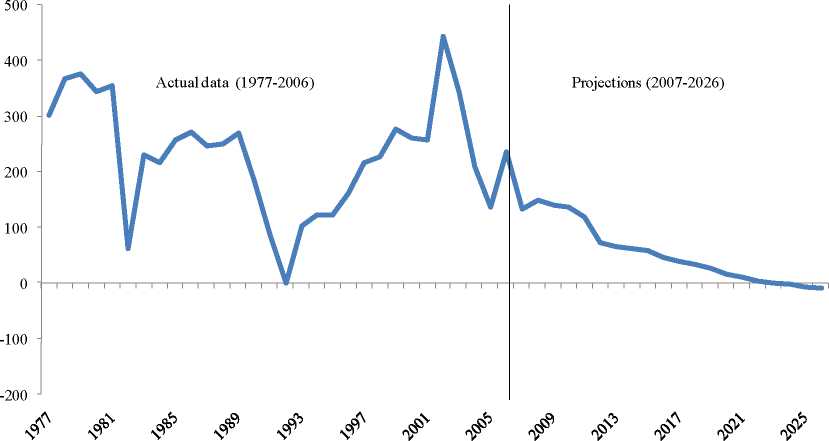12
means that the importance of hours worked as a source of economic growth will fall in
the future. Productivity growth will hence assume a greater relative importance as a
source of economic growth. It is estimated that from 2006 to 2026 productivity growth
will account for 83 per cent of economic growth as employment growth is expected to be
only 0.3 per cent per year over the period. Once employment growth disappears around
2023, economic growth will in effect become synonymous with labour productivity
growth. In the future, if Canada wants to increase GDP, it will have to increase labour
productivity.
Chart 2: Net Labour Force Growth in Canada, 1977-2026
Thousands

Source: Labour force estimates for 1976-2006 from Statistics Canada, Labour Force Survey; for 2007-2026 from Statistics
Canada, Population Estimates and Projections.
Note: Projected labour force estimates are calculated by multiplying projected population with the 2006 labour force participation rates.
2) Productivity and GDP per capita
Gross Domestic Product per capita, the most widely used measure of living
standards, can be decomposed into the product of labour productivity (defined as output
per hour worked at the total economy level), the average number of hours each employed
person works, and the proportion of the entire population that is employed.6 Likewise, the
growth rate of real income as proxied by the GDP per capita growth rate can be
approximately decomposed into the summation of the growth rates of these three
variables.
Summary Table 2 demonstrates this decomposition using Canadian data for the
1947-2006 period and sub-periods. It provides estimates of the levels and growth rates of
6 Changes in terms of trade can also contribute to changes in real income. There were particularly important
for Canada in the 2002-2005 period, but their contribution over long periods is small (Kohli, 2006). The
decomposition of GDP per capita in the text ignores the role of terms of trade effects.
More intriguing information
1. Regional dynamics in mountain areas and the need for integrated policies2. The name is absent
3. The name is absent
4. The name is absent
5. El Mercosur y la integración económica global
6. Kharaj and land proprietary right in the sixteenth century: An example of law and economics
7. A methodological approach in order to support decision-makers when defining Mobility and Transportation Politics
8. Testing Hypotheses in an I(2) Model with Applications to the Persistent Long Swings in the Dmk/$ Rate
9. WP 36 - Women's Preferences or Delineated Policies? The development or part-time work in the Netherlands, Germany and the United Kingdom
10. Wirtschaftslage und Reformprozesse in Estland, Lettland, und Litauen: Bericht 2001